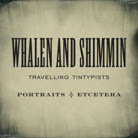I had great intentions last year, to create a hat to wear with my bathing costume, during our two mile stroll down to the water - but it didn't happen.
And I had great intentions this year, to create a fanchon bonnet to wear with my 1868 dress when we attended the vintage baseball game and held our picnic - but it didn't happen and I even had the frame!
So I really needed a come up with a "make-do" hat quickly.
During the mid-19th century, hats were most commonly worn by girls or young women, but there were occasions when they were acceptable for a woman of "certain age" and picnics were one of those occasions. Additionally, they were also acceptable when visiting a watering place, such as Mackinac.
Ladies straw hats of the period typically had low crowns and shaped brims, the above image shows a very common style.
Here's a couple vintage images too:
So, on to my "make-do" version:

Unfortunately, I failed to take photos of the process. But I started with a cheapy straw from the craft store, that was in the Halloween box.
First, I steamed and flattened the crown. Next I chopped about 3" off the brim. I wired the edge (hardware store wire, not millinery) and then covered the raw edge with grosgrain ribbon. Petersham would have been the proper thing to use, but I didn't have any and this was a "use what you have" project. A bit a shaping and I was making progress.
The final step was to add some simple ribbon trim - actually bonnet ties removed from a friend's bonnet, she didn't like the red and I replaced them for her. I didn't even iron out ends that had been gathered and fastened to the bonnet!
The red was a nice contrast to my dress and also coordinates well with my red and black bathing costume.
Did it work for the weekend? YES!

I still plan to make the fanchon, but I rather like my sporty straw too!























